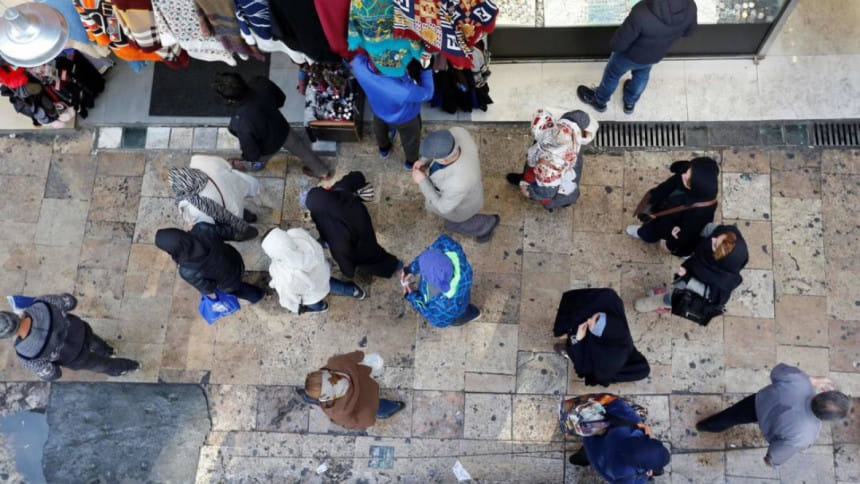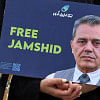What has gone wrong in Iran?

Hundreds of Iranians came onto the streets on December 28, 2017,in an impromptu demonstration in the city of Mashhad protesting high prices of daily necessities and rampant corruption. They denounced President Hassan Rouhani and chanted slogans against the Supreme Leader Ayatollah Ali Khamenei. The protests have now spread all over Iran including Tehran, and so far 22 people have been killed, including a policeman. Several hundred agitators have been arrested.
Surprisingly, the protests started in Mashhad and then spread to Qom, religious strongholds of the clerics. What is worrisome for the ruling clergy is that the demonstrators chanted slogans in favour of the late Reza Shah, the founder of the ousted Pahlavi dynasty. However, hard-line pro-government supporters came in large numbers onto the streets to counter the anti-corruption activists.
Is it really the high prices of food or are there some other reasons for this uprising?The current economic situation of Iran does not seem to be the main narrative behind this sudden unrest. It is true that some food and fuel prices have gone up but this outburst looks like an amalgamation of frustration and disillusionment over corruption, repression of political dissidents, freedom of expression and impatience over the slow progress in economic improvement.
Since the signing of the Nuclear Deal with the West (JCPOA, June 2015), which removed four decades of sanctions, Iran's economy, dominated by the oil and gas sectors, received a boost mainly due to unhindered exports.The economy grew by 13.4 percent registering a GDP of USD 412 billion (2016, WB).Inflation came down from 11.9 percent in 2015 to nine percent(2016, WB). But the unemployment figures creeped up to 12.6 percent (2016, WB) meaning that over 3.3 million educated young people were looking for jobs. New jobs could not be created because of slow progress of investments. People had supported Rouhani's nuclear deal with the expectation that economic conditions would improve dramatically within a short time. The economic situation has indeed improved compared to what it was before signing JCPOA—but not fast enough for the working and middle-income segments of the people.
The current unrest in Iran has come as a welcome development for Iran baiter President Donald Trump. Though Trump's tweets do not reflect US foreign policy, some of his latest tweets reveal that he is happy anti-clergy protests have flared-up in Iran.From Trump's writings it is clear that he wants regime change in Iran—"The world is watching"; "Failing at every level. Time for change". Tehran reacted strongly and trashed Trump's tweets saying, "Iranian people give no credit to the deceitful and opportunist remarks of Mr Trump."
What is significant here is that Trump has to certify that Iran is in compliance with the nuclear deal every 90 days to Congress. Around mid-January 2018 the certification issue will come up again and one wonders whether Trump will scrap the deal and impose fresh sanctions on Iran.The House of Saud and Trump are in sync as far as the riots in Iran are concerned. Riyadh is also happy and watching the developments closely. One wonders whether these two have been fanning the unrest in Iran, as Tehran has accused.
Supreme Leader Khamenei on January 2, 2018 in a statement has accused Iran's enemies (Washington?) for providing "cash and arms" for regime change. Interestingly, hard-line Khamenei and Rouhani do not necessarily agree on all issues. Iran's democracy has several centres of powers but two centres are prominent—the hard-line clergy and the moderates. Hassan Rouhani is a moderate who has gained acceptability with the West. The hard-line clergy accuses Rouhani of failing to deliver on economic promises even though there are no sanctions. If the hardliners succeed in undermining Rouhani it will mean the end of JCPOA. And without the JCPOA Iran will find it daunting to reform the economy.
What is happening in Iran is neither a political movement nor a revolution. However, it will certainly produce ramifications internally within Iran and externally in the Middle East region. Internally, Rouhani will be compelled to push economic reforms faster, stamp out corruption and ensure more democratic rights to the people. Rouhani said demonstrators were "absolutely free" and had the right to protest against the government and acknowledged that some of the protestors' grievances were legitimate, but warned demonstrators not to be violent.Rouhani promised to redress the grievances of the agitators.Externally, Tehran will have to step back from supporting proxy wars in the Middle East and re-establish diplomatic relations with Saudi Arabia. Sanctions may be staring Tehran in the face once again, if JCPOA is terminated.
Looking back, the 2009 Green Movement was triggered by Mir Hossein Mousavi to oust the newly elected president Mahmoud Ahmedinejad on allegations of vote rigging.But it was firmly crushed by the Iranian Revolutionary Guard Corps. On the current unrest Khamenei and Rouhani will definitely act together to bring the situation under control, if necessary with harsh means. As social media is seen as the culprit in fomenting the unrest, authorities have cracked down on access to social media tools such as Instagram and Telegram. The powerful Revolutionary Guard Corps, whose mandate is to safeguard the Islamic Revolution, vowed to crush the anti-government protests.
The current uprising brings Iran's demography in focus. The Iranian society with a population of 81.59 million has a well-established educated middle class. The median age in Iran is 30.1 years. Normally young people around the age of 25 drive anti-government agitations. This time the numbers are far less than in 2009.
Rouhani has steered Iran's nuclear deal with the West quite skilfully and was elected for the second term in May 2017 with a huge mandate. He took office in August 2017 and it is unlikely his government will collapse because of the unrest.
Mahmood Hasan is former Ambassador and Secretary.










Comments